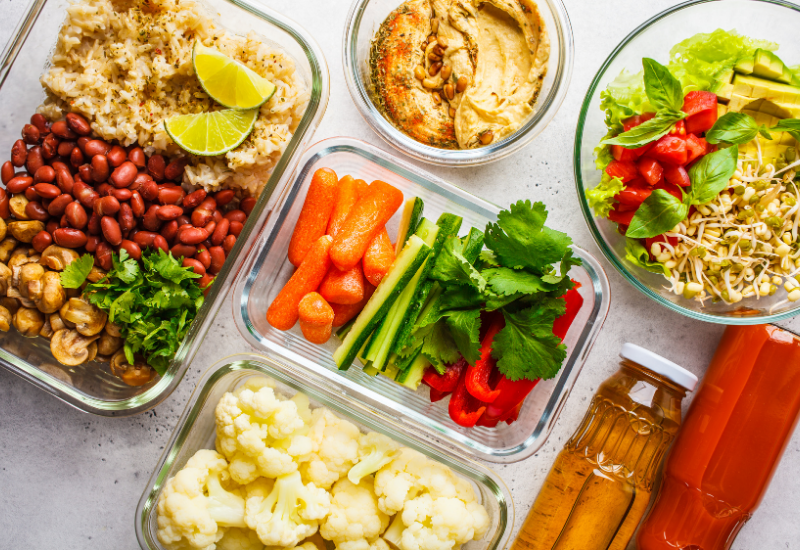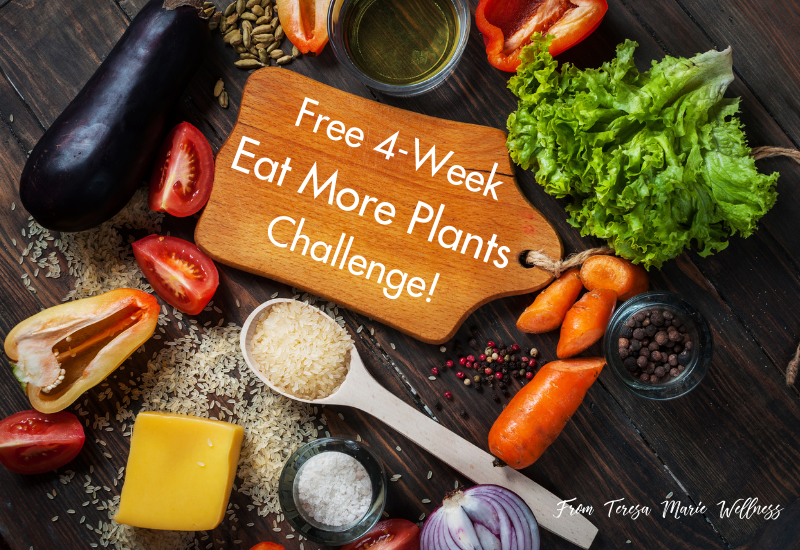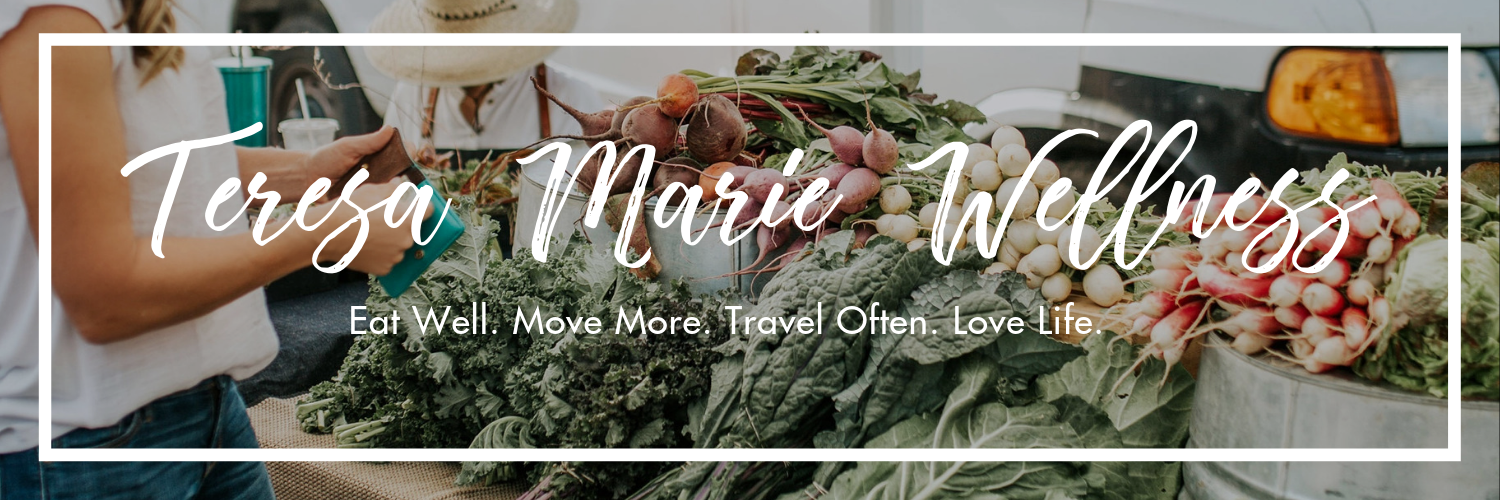Part 6: Preventing Food Waste through Proper Food Storage

When it comes to eating an unprocessed, plant forward diet, there are a few challenges. First, what to eat? Then, how to prep and cook it so that you’re excited to eat it. The final challenge is making sure you eat all your fresh ingredients, or store them properly so they don’t spoil first. Preventing food waste through proper food storage is exactly what we’re going to talk about today.
This is Part 6 of the 4-Week Eat More Plants Challenge. As a reminder, here’s were we’ve been and where we’re going with this challenge:
- Welcome: What is a Plant Forward Diet
- Setting up Your Plant Forward Pantry
- When Organic Food is Worth the Cost
- Calculate How Much Protein YOUR Body Needs
- The Best Sources of Traditional & Plant Based Proteins
- Preventing Food Waste with Proper Food Storage <== You are Here
- Which Plants Can Cause Bloating and Inflammation
- Cultivating Sustainable Healthy Habits
Preventing Food Waste
Fresh foods are just that — FRESH. Lacking preservatives, they don’t have the same shelf life as a Twinkie (and for that, your body is grateful!). With Plant Forward cooking, we put a huge focus on meal prep to maximize your time in the kitchen. But it does not matter how many amazing ingredients you’ve purchased or delicious meals you’ve prepped if you don’t store them correctly or eat them before they spoil.
There is a bit of knowledge involved with preventing food waste through proper food storage. From how long raw ingredients last, where to store them to what you should do with them after they are cooked. All these tidbits will lead to not only preventing prevent food waste, but also saving you money. So let’s dig in.
Fresh Ingredient Lifespan
The first step here is to know just about how long fresh foods can live and where to store them. Some do better in the refrigerator, while others do better on the counter, in a cool and dry location. When you know about how long your ingredients will last, it’s super easy to prioritize your cooking.
This chart includes a list of most of the fresh foods you’ll find in my Clean & Colorful: Plant Forward Basics Recipe Guide. It includes where you should store each ingredient, and about how long it will be safe to eat. Click on the image or the button below to download and print a PDF and store it with the ret of your challenge materials.
Using all your Fresh Ingredients
I have two favorite key strategies I use to make sure no veggies go to waste in my kitchens. Putting these into practice in your own Plant Forward Kitchen is not only easy, it will save you time and lots of money.
1. Buy Only What You Have a Plan to Use
The best way to make sure you use all your fresh ingredients is to go shopping with a plan. Then obviously, buy only exactly what you need. This means you’ll need to know what you’re planning to cook before you go shopping.
This can be made very simple with one of my Clean and Colorful Recipe Guides or Meal Plans. Each guide has simple recipes with an easy to complete shopping list organized by food group. Shopping for exactly what you need has never been easier! There is also no shortage of recipes in the interweb (Pinterest is great) and in your favorite magazines. So do you research, pick some recipes you’re excited to eat, make a list and go shopping with a plan.
2. Kitchen Sink Recipes
Now, even when you go shopping with a plan, sometimes you still have fresh food left towards the end of the week. What do you do when you have a small collection of fresh ingredients and no recipes? This is where the beauty and magic of the “Kitchen Sink” salads and soups comes in so handy!
It’s so easy! Dig through your fridge and find anything that is going to go bad in the next few days: veggies, fruits, and pre-cooked grains, beans and/or protein. Just cut up all your fresh veggies into uniform pieces. If you’ll be eating them in the next day. Make a salad. Toss everything in a simple olive oil and vinegar or citrus mixture with fresh cracked pepper.
If you can’t eat your kitchen sink concoction in the next day, make a soup! Simply sauté your veggies in a little olive oil and garlic. If you have chicken or turkey you want to use up, toss it in and sauté to brown the edges now. Then stir in some stock, and add any cooked beans or grains. Season with fresh herbs or spices, let simmer for 20-30 minutes or more. Final season with salt and pepper. If you have beans to use up, I love making a chili.
Cooking up a batch of a kitchen sink soup or chili will automatically add 3 days of life to your fresh food. But if you don’t think you’ll be able to get to it in that timeframe, pop it in the freezer. It’ll be safe there for another 4-6 months.

Storing Cooked Meals
We know that Plant Forward cooking takes time. So maximizing your time in the kitchen and cooking in bulk can save you so much time throughout the week. It takes just about the same amount of time to make six meals as it does to make 2, so why not make more? This is why just about all of my recipes are set to serve six.
Once you prepare a plant forward meal, you simply dish out what you’ll be eating then store the rest in single serve, airtight containers. Look for something microwave and freezer safe. Your pre-portioned, cooked meals are good in the refrigerator for 4-6 days. If you won’t (or don’t want to) eat all the portions in one week, pop 2-3 in the freezer. Cooked meals are safe in the freezer for an additional 4-6 months!
Keep in mind, not all meals are created equal when it comes to freezing. When fresh ingredients freeze, they will defrost soggy. Which is fine for dishes like soups, pastas, and chilis. It’s not ideal for crispy dishes like fresh salads or power bowls. It’s better to prioritize those and eat them fresh.
Reheating Stored Meals
You can reheat any pre-cooked meal in just a few minutes in the microwave. I like to make sure I transfer it into a glass dish if it’s stored in plastic. You can also reheat most dishes in a skillet on the stove or a baking dish in the oven. Just keep in mind that the meal is already full cooked and you’re just re-heating to your desired temperature.
If you are planning to use up a dish you’ve stashed in your freezer, my best advice is to pull it out of the freezer and let it defrost in the refrigerator the day before you plan to eat it. You can reheat dishes from frozen but it takes longer and the texture can be less desirable.
How do you know when your food has been wasted?
I can’t wrap up this post with a little note on knowing when to say when with spoiled food. You probably know this, but food generally spoils due to overgrowth of bacteria which can be harmful to your health. And if not harmful, spoiled food tastes gross. You can see from the chart that food spoilage is generally a range of time, for a multiple of different factors.
The best way to know for sure if your food is past its prime is to first, visually inspect it. Does it look weird? Can you see mold or anything that looks off? Is there a layer of slime? Any brown, fuzzy or mushy spots? Obviously if it looks off, toss it ASAP.
If it looks ok, give it a secondary sniff test. Does it smell like it should? With raw food this can be very easy to identify or not so clear. But I can promise you that the old adage “When in doubt, throw it out” is a golden rule. As much as I am an advocate for preventing food waste, I’m a larger advocate for protecting your health. Food born illness can be an awful, toxic and in some cases very a serious issue. It’s simply not worth the risk.
In Summary & Next Steps
I know that’s a lot of information. But knowing how long your ingredients will last and how to cook and store them properly is a huge part of successful plant forward eating. And like I said earlier, preventing food waste will ultimately save you so much time and money! Now, put it into practice:
- Print your Plant Forward Ingredient Lifespan Chart. If you are signed up for the 4 week challenge, add it to your small binder or folder with your other challenge printable action sheets.
- If you haven’t already, make sure you have single serve, air-tight containers in a few different sizes. Freezer and microwave safe are important features to look for as well. These glass ones are my favorite, but shop around until you find something you love.
- If you want to make weekly meal planning simple, be sure to grab one of my Clean & Colorful Recipe Guides so you head to the store with a plan of what to buy and then have a plan for what to cook all week long.
- Get comfortable with your food! Play with new flavors and textures in your “kitchen sink” salads and soups. They may not all be world class wonders. But when you’re staring with fresh ingredients, you know at the very least, your body (and the planet) will be happy!
- Would creative (virtual) cooking lessons be fun and helpful? I’m thinking about hosting one per month, shoot me note at teresa@teresamariewellnes.com and let me know if you’d want to participate and/or what you would be most excited to learn.
Up next in the 4-Week Eat More Plants Challenge: Which Foods Cause Bloating & Inflammation. If you’re not signed up for the free challenge yet, you can do that right here!

There you have it! You’re well on your way to adopting a Plant Forward diet and feeling the amazing benefits!
About The Author
Teresa Howes
I’m a board certified holistic nutritionist, certified personal trainer, plant forward & flexatarian lifestyle enthusiast and self proclaimed Veggie Ninja. I’m here to inspire and illustrate how delicious, simple and fun healthy living can be!
Related Posts
A Healthy Gut Party (a.k.a How to Restore Gut Health After Antibiotics)
I am an advocate of a healthy diet and how the right food is at…
November 28, 2024The Perfect Plant Forward Thanksgiving
The word “healthy” is generally not the first thing to jump in your…
November 18, 2024



Part 7: Which Plants Can Cause Bloating and Inflammation | Teresa Marie Wellness | 4th Mar 21
[…] Preventing Food Waste with Proper Food Storage […]
Part 8: Cultivating Sustainable Healthy Habits | Teresa Marie Wellness | 4th Mar 21
[…] Preventing Food Waste with Proper Food Storage […]
Part 1: What is a Plant Forward Diet? | Teresa Marie Wellness | 4th Mar 21
[…] Preventing Food Waste with Proper Food Storage […]
Part 2a: How to Stock The Plant Forward Pantry | Teresa Marie Wellness | 4th Mar 21
[…] Preventing Food Waste with Proper Food Storage […]
Part 3: Is Organic Food Worth the Cost? | Teresa Marie Wellness | 4th Mar 21
[…] Preventing Food Waste with Proper Food Storage […]
Part 4: How much protein do you need? | Teresa Marie Wellness | 4th Mar 21
[…] Preventing Food Waste with Proper Food Storage […]
Part 5 The Best Plant Based Protein Sources | Teresa Marie Wellness | 4th Mar 21
[…] Preventing Food Waste with Proper Food Storage […]